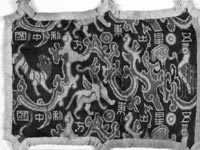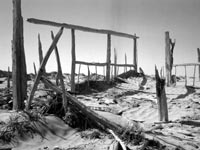|

The Chinese
characters embroidered on a colourful brocade of mysterious pattern found
by archaeologists in 1995 read: "China will rise when the five stars
appear in the East together."
|
Long,
long ago there was a king. He had 300 soldiers, 3,000 residents in his state and
one gold camel, which was his dearest possession.
But he fell in love with a woman who was also loved by the king of another
state, and thus a war was started. God, angered by the war, blew up a black
sandstorm that lasted for 80 days and buried the entire kingdom, including the
gold camel.
More than 2,000 years later, in 1901, a British explorer named Marc Aurel
Stein (1862-1943) trekked into the ruins of the kingdom far out in the desert,
and the world then heard for the first time the name of Niya - as dreamlike as
the Uygur legend about it that you have just read.
Niya, believed to have flourished from the 1st century BC to the 4th century
AD, has remained the best preserved and one of the largest ruins of the city
states that were scattered along the ancient Silk Road about 1,500 years ago.
It became known as the "Pompeii of the Silk Road."
Daunting excursions
Official approval for Sino-foreign joint excavations at the site was given in
1994, and archaeological digs there by a Sino-Japanese joint research team
started in the same year.
 Preparation for the joint project started in 1988, funded
largely by Yasutaka Kojima, a Japanese Buddhist monk, who had offered to support
research at another Buddhism site in Xinjiang after having helped with the
restoration of the Kuqa Buddhist Grottoes.
Preparation for the joint project started in 1988, funded
largely by Yasutaka Kojima, a Japanese Buddhist monk, who had offered to support
research at another Buddhism site in Xinjiang after having helped with the
restoration of the Kuqa Buddhist Grottoes.
Researchers have only recently announced the conclusion of their fieldwork.
Niya is located about 100 kilometres to the north of the town of Minfeng at
the southern tip of the Taklimakan Desert in Northwest China's Xinjiang Uygur
Autonomous Region.
To get there one has to trek more than 30 kilometres north into the desert
from a small oasis called Kabake-Arsihan. The small oasis is home to about 110
households, whose members use water from wells dug in the middle of the dried
bed of the Niya River.
The site chosen for excavation was one of about 10 discovered ruins in the
desert, among which were Loulan (Kroraina), Hotan (Khotan) and Kuqa (Kucha).
When eight Chinese and Japanese researchers entered the desert on November 4,
1988 to investigate the Niya site, the only helps they had were the rough maps
drawn by Stein, and their compasses, telescopes and 20 camels.
 The project stretched into years as the researchers could
only enter the site every October and stay there for only one month. It is the
"least windy" month, although the sandstorms are still vicious enough to destroy
cameras, and the "most people-friendly," although the temperature went up to 30
C during the day and down to 20 C below zero during the night.
The project stretched into years as the researchers could
only enter the site every October and stay there for only one month. It is the
"least windy" month, although the sandstorms are still vicious enough to destroy
cameras, and the "most people-friendly," although the temperature went up to 30
C during the day and down to 20 C below zero during the night.
"I will always remember the moving moment when we finally saw the ruins of
Buddhist stupa of Niya after wandering seven days in that no-man's land of a
desert with no clear idea of where the site was," said architect Sun Yuexin who
has been a member of the team from the outset.
Spread out before them exposed in the sand desiccated remains of long-dead
variform-leaved poplar trees.
The site stretches about 25 kilometres from north to south and 7 kilometres
from east to west, with the 6.5-metre-tall stupa at the centre.
Researchers have now found the vestigial remains of about 100 dwellings,
graveyards, animal sheds, orchards, gardens, agricultural fields and lines of
trees.
They were surprised to see, when they dug their way into the houses, all
kinds of farm tools and household items - iron axes and sickles, wooden clubs,
pottery urns and jars filled with various crops - all very well preserved.
It looked as if dwellers of the city-state now long buried in the sand had
just left home and would return at any time, as is recorded in a book titled
"Niya: Paradise Regained," which the researchers published in 1995.
Dwellings unearthed in 1994 showed residents of Niya usually had at least a
kitchen, a living room and a storage room. They built their houses with wood and
plaster.
From the dried-up corpses found on the site, some anthropologists speculate
that the Niya people were of Caucasian origin. Others say they were descendants
of the soldiers of Alexander the Great (356-323 BC), who launched expeditions to
the Orient, as the soldiers are said to have interbred with the local people.
Dazzling finds
Sun said their most exciting moment in 10 years of trekking through the
desert was on the evening of October 11, 1995.
The researchers, who had finished the day's fieldwork, were on the way back
to their tents when they saw a large block of dried wood rising obliquely from
the sand.
"We hesitated, a bit reluctant to stop the jeep and take a look. We were
really tired, but the wood was so clean, decent and good-looking under the blue
sky," said Sun.
Walking nearer, they saw it was the head of a coffin. No one was prepared for
the sudden jubilation that erupted when they opened it.
They were stunned by a gorgeous embroidered blue brocade, dazzling in the
dusky shafts of dying light lying there before them. On it were embroidered 11
Chinese characters "Wanghou Hehun Qianqiu Wansui Yi Zisun," meaning may this
royal marriage be blessed with long life and a myriad of descendants.
As the brocade was lifted away, the mummies of a man and a woman were
revealed.
Later, carbon dating ascertained that the coffin was from the Han Dynasty
(206 BC-AD 220).
In an area of more than 1,000 square metres, researchers found a total of
eight graves. The greatest find was a colourful embroidered brocade with
mysterious patterns and eight characters reading "Wuxing Chu Dongfang Li
Zhongguo" - China will rise when the five stars appear together in the East.
This actually describes the astronomical phenomenon of Venus, Jupiter,
Mercury, Mars and Saturn appearing in a line in the sky when viewed from the
earth. This happened most recently in May, 2002 and will happen again in
September 2040.
In 1996 researchers unearthed a clay castle in which wooden tablets inscribed
with the long-dead Kharoshiti language were found.
The large number of wooden tablets with Kharoshiti inscriptions is the most
significant find of recent years at the Niya site, said Sheng Chunshou, head of
the Xinjiang cultural heritage administration.
Sheng, who declined to reveal the exact number of tablets, said researchers
are now focusing on deciphering them.
One of the ancient Indo-Aryan languages, Kharoshiti dates back to the 5th
century BC and was spoken in the city states in the Taklimakan area for nearly
800 years - from the 3rd century BC to the 4th or 5th century AD.
The common language used in the Silk Road trade and in the teaching of
Buddhism died out after those kingdoms vanished more than 1,000 years ago.
In the early 1900s, The explorer Stein astounded the world with a find of
more than 700 wooden tablets bearing the Kharoshiti language, which he collected
in his four visits to Niya.
Relics from Niya, collected by the Sino-Japanese research team, are kept at
the Xinjiang Museum and the Xinjiang Cultural Heritage and Archaeological
Research Institute. Chinese and Japanese researchers are now studying them, said
Sun.
"With a site the size of Niya, it may take more than 100 years to complete
investigation of it and even more time to study and understand it," said Kojima.
The fieldwork may well be started again.
In fact, researchers say they plan to trek into Dandanwulik, a newly
re-discovered site west of Niya, this coming October, where delicate Buddhist
murals have been found.